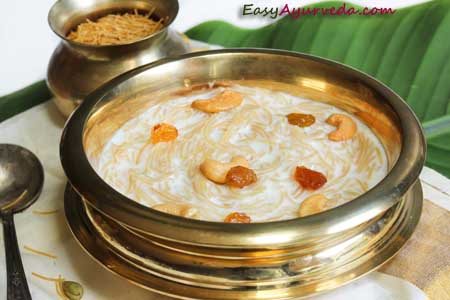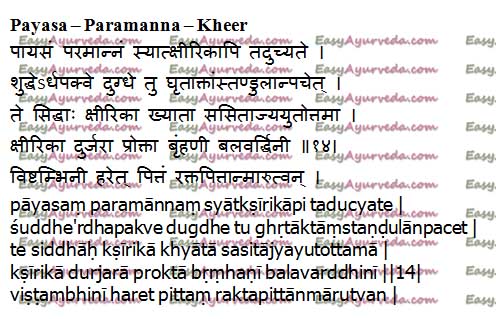Kheer – Payasam: Ayurvedic Method Of Making, Benefits, Side Effects
This article is by Dr MS Krishnamurthy MD (Ayu), PhD.
Kheer or Payasam is a well known sweet recipe prepared throughout India. In Earlier centuries, it was prepared just with rice (Paramanna – parama (best) among the eatables), now a days several base materials are used to prepare the kheer. Depending upon the main ingredients it imparts health benefits along with general action of kheer or payasam.
The sweet preparation is a customary recipe in Indian meals/lunch, especially during the joyful occasions like marriage ceremonies, sacred thread wearing (upanayanam), naming ceremony, special ceremony related to pregnancy (dohada/seemantonnayana) etc.
In several temples also it is offered to the God and later served as Prasadam. So kheer stands as a unique preparation in several instances.

Table of Contents
Classical reference

Classical reference of Kheer and its qualities as well as health benefits are explained here below –
Reference: Bhavaprakasha – Kritanna varga/14
What is kheer?
Milk is taken and cooked and condensed to get thick milk by reducing it to half. Rice is taken (even the broken rice can be used) and fried with ghee. This fried rice is added to the condensed milk and cooked well. As it boils slight ghee and sugar candy are added (jaggery or coconut milk can also be added) and heating is continued till the rice particles are cooked well and become soft and fine.
Note: As per ones desire cardamom, saffron, cashewnut or Badam can also be added.
Synonyms, qualities, uses
Synonyms: Payasam, Paramanna, Ksheerika, Ksheeranna payasam etc
Medicinal qualities of Kheer –
Durjara (delayed digestion/ slow digestive),
Brimhana (nourishing/nutritive),
Balavardhaka (tonic, energizing),
Vishthambhakaraka (blocks the channels),
Pittahara (pacifier of pitta dosha),
Raktapittahara (pacifier of bilious disorders or bleeding diseases),
Balances Vata Dosha
Jatharagni mandakaraka (pacifies excess digestive fire) etc.
Uses of Payasam –
As the kheer is nutritive and nourishing one, it is indeed a well recommended diet in emaciating disorders and leanness. As it is a coolant, in paittic disorders it is highly beneficial. But kheer is to be avoided in those who have very poor digestive capacity. Also the individuals who are having the health issues related to urinary disorders and type II DM etc should better to avoid it or advised in very less dosage.
Also the patients with Kaphaja disorders like cough , asthma, breathlessness, cold and phlegm should not prefer it in routine. If so desired to have such people can enjoy it only in noon in less amount.
In total Payasam is suitable to those who have good digestive fire and who wishes to gain the weight.
Now a days as several kind of kheer/payasam is being prepared all such recipes will have same properties but with little modified actions based upon the base materials used.
Click to consult Dr MS Krishnamurthy MD (Ayu), PhD








